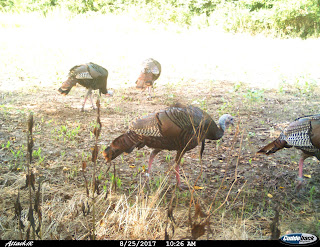Not us, we keep the cameras running and just change our focus
to turkeys. Late winter and early spring
is an excellent time to run cameras and you can learn a lot about your local
flock in preparation for spring season.
Here are a few ways we use our trail cams to get the drop on our turkeys.
- We move our cameras to areas we plan to hunt when the spring season opens. For us, in northern MO, this means a lot of field corners and edges. By doing this, we can gauge the times of day that turkeys show up in the fields. Turkeys can range far and wide, but we seem to notice a cycle to their movements - sometimes we see that birds are showing up every 2nd or 3rd day at roughly the same times.
- We put cameras near known roosting areas. Where we hunt, this means hanging cameras on logging roads, ridge lines, or open glades inside the timber. When we get pics of birds in the first or last hour of the day, we assume they are roosting close to the camera location. Sometimes birds will roost in the same area several days in a row, other times they seem to cycle through roost areas once every few days. The cameras can even help us figure out which way they go after fly down.
- We also try to gauge how weather affects the birds’ movements. One way we do this is to put cameras in areas protected from the wind such as hollows or leeward slopes. These are the toughest camera spots to peg and we don’t get as many pics on these cameras as other more predictable spots. But we always get some really windy days during the spring season and it helps to have some clue where the birds might be in those conditions.
- From trail cam pics we can also see when the flocks seem to break up - we'll go from getting pics with big groups of birds one week to getting pics with small groups or individual hens and toms the next. As the season progresses it's amazing how few pics we get of the hens - it's like they go underground - in reality this signals to us that they are spending more time on nests.
It’s a little different than deer season but your trail
cameras can be a great turkey hunting tool.
We are not really patterning specific birds, but the easiest way to put
a big tom gobbler in the logbook is to be where he wants to be, and the trail
cameras help us identify those places and times. Getting a pic full of big tom gobblers at
7:00 am is very useful and gets our blood pumping as much as any big buck pic.
OutdoorMetrix - Learn More.
OutdoorMetrix - Learn More.











